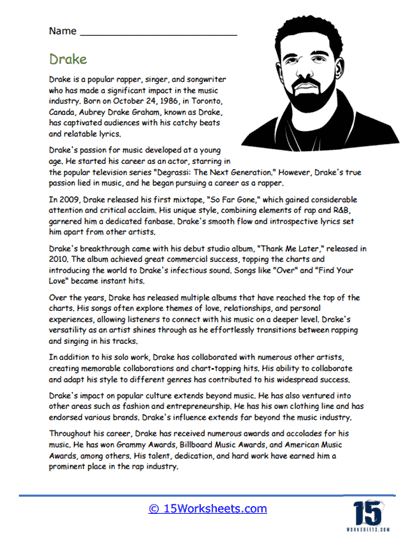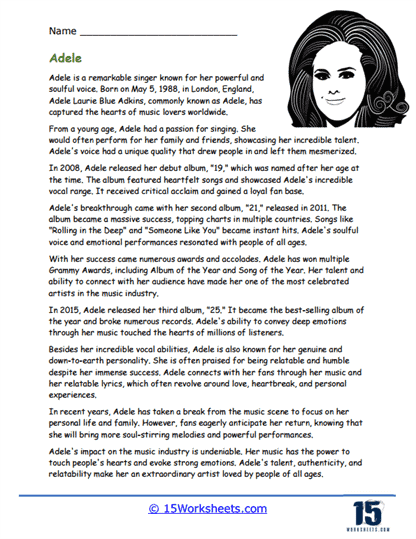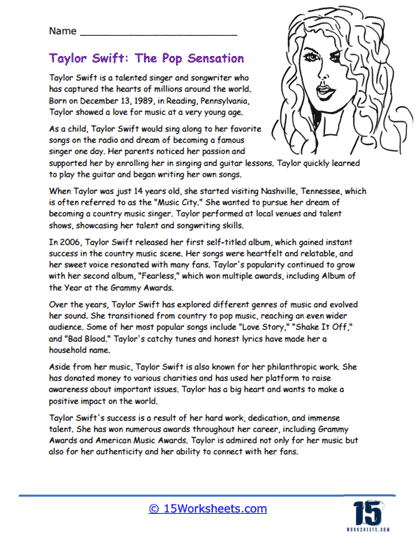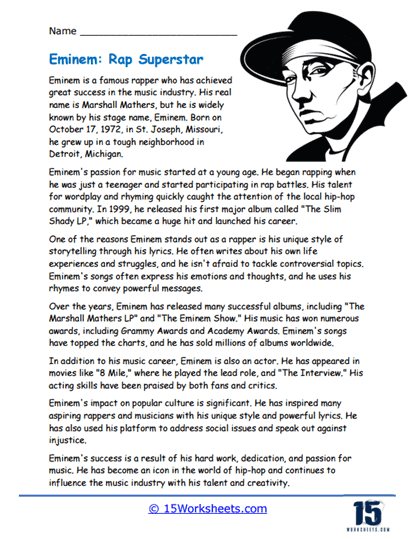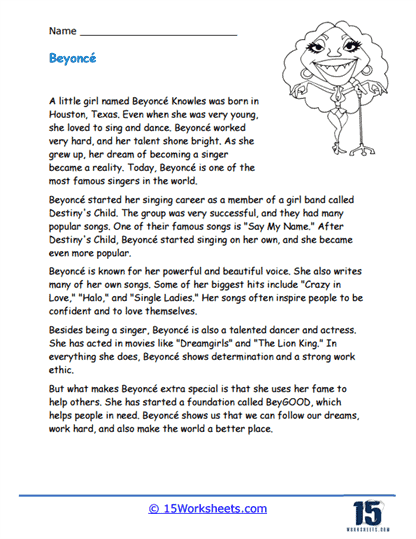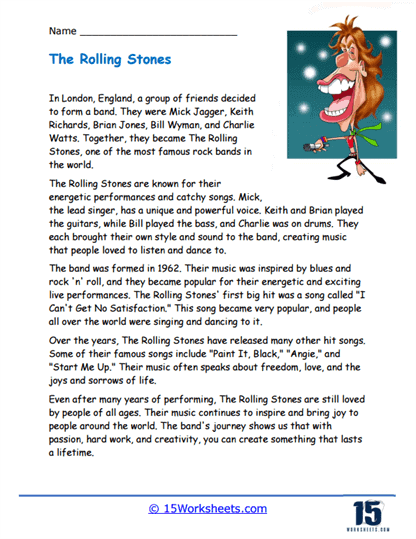Music Industry Worksheets
All About These Worksheets
These reading worksheets all look at different aspects of the music industry and artists in the music world. Students will learn many new aspects of this area of life and its culture. Students will then be asked to answer a variety of questions about what they have read.
These worksheets contain passages, articles, or excerpts related to various aspects of the music industry, followed by questions to gauge the reader’s understanding of the text.
The questions are designed to:
- Check for basic understanding of the content (e.g., “Who is the artist mentioned in the article?”)
- Test for deeper comprehension (e.g., “Why did vinyl records decline in popularity during the 1980s?”)
- Encourage critical thinking or analysis (e.g., “How might streaming platforms impact emerging artists differently than established ones?”)
The overarching goal is to blend literacy skills with domain-specific knowledge, giving students or learners a more enriched and comprehensive understanding of the music industry.
What is the Music Industry?
The music industry is a vast and dynamic field that encompasses the creation, production, distribution, and promotion of music. It plays a pivotal role in shaping popular culture and has undergone significant changes throughout history due to technological advancements and evolving consumer preferences. Here is an overview of various aspects of the music industry:
Making Music – The music industry begins with the creation of music. Songwriters, composers, and musicians write and compose music across various genres such as pop, rock, hip-hop, country, classical, jazz, and more. They often collaborate with other artists to create songs and albums. There are talented people called songwriters and musicians who create music. They come up with catchy tunes, write lyrics, and play musical instruments to make songs. Some people sing, while others play different instruments like the guitar, piano, or drums.
Recording Music – Once the music is created, it’s recorded in a special place called a studio. Recording artists, bands, and producers work together to capture the performance and produce high-quality audio recordings. Advances in technology have made it possible to record music outside traditional studios, with home studios becoming more prevalent.
Record Labels – When the music is recorded, there are companies called record labels that help the artists. Record labels play a significant role in the music industry. They discover and sign talented artists, finance the recording process, and handle the marketing, promotion, and distribution of music. They often provide resources, expertise, and industry connections to help artists succeed.
Publishing – Music publishing involves the administration of copyrights and the collection of royalties. Music publishers work closely with songwriters and composers to protect their intellectual property rights and license their music for various uses, such as recordings, films, commercials, and live performances.
Distribution – Music distribution has experienced a significant shift in recent years. Traditionally, physical formats like vinyl records, cassettes, and CDs were sold in retail stores. However, with the rise of digital music platforms and streaming services such as Spotify, Apple Music, and YouTube, online distribution has become the primary means of music consumption. These platforms make music accessible to a global audience, allowing listeners to stream or download music on various devices.
Live Performances – Live performances, including concerts, festivals, and tours, are crucial for artists to connect with their fans and generate revenue. Artists earn income through ticket sales, merchandise, sponsorships, and other ancillary revenue streams. Live performances provide an opportunity for artists to showcase their talent and build a loyal fan base.
Artist Management – Artists often work with managers who handle their career strategies, bookings, contracts, and overall business affairs. Managers act as intermediaries between the artists and the industry, ensuring that the artists’ interests are represented and facilitating their professional growth.
Promotion and Marketing – Promoting music is essential for reaching a wider audience. Record labels, managers, and artists employ various marketing strategies, including social media, radio airplay, music videos, interviews, press releases, and collaborations, to generate buzz and increase visibility. Digital marketing has become particularly significant, allowing targeted advertising and personalized recommendations based on user preferences.
Industry Challenges – The music industry faces numerous challenges. Piracy and illegal downloading have had a significant impact on revenue streams. Additionally, the rise of streaming services has changed the dynamics of revenue distribution, with artists often receiving relatively small royalties. However, these services have also made music more accessible and facilitated the discovery of new artists.
Independent and DIY Artists – In recent years, independent artists have gained more prominence. With the advent of affordable recording equipment, online distribution platforms, and social media, artists can now produce, distribute, and promote their music independently. This has allowed for greater creative control and direct connections with fans.
The music industry is a complex ecosystem with diverse stakeholders and ever-changing dynamics. While technology continues to shape the landscape, the fundamental importance of music as a form of expression and cultural phenomenon remains constant.






